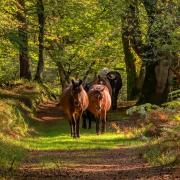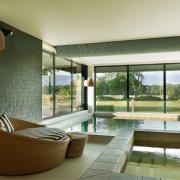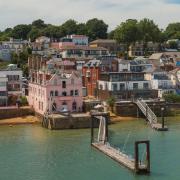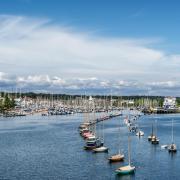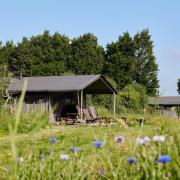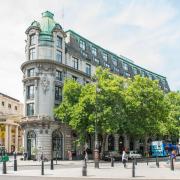I am standing on a hot, dusty, street. It’s chaotic with horns blaring. A man carrying a long basket of bread passes, navigating the melee of people and traffic while balancing the basket on his head. This is Cairo, the 15th largest city in the world, city of treasures and gateway to the pyramids and I am here to discover it.
‘Honking is the first language of Egypt,’ laughs Egyptologist Mohamed Younis, our guide throughout the trip and whose enthusiasm both for his homeland and his subject is infectious.

I doubt the Earl of Carnarvon of Highclere Castle had these sort of traffic problems back in the 1920’s when he came on a voyage of discovery, but the sense of anticipation and adventure is the same, one that’s as intoxicating as the smells of spice and incense in Khan El-Khalili Market. However, my journey will be a little more sedate with a fair bit of 21st-century luxury thrown in.
The Earl was instrumental in the discovery of Tutankhamun and I am following in his footsteps. ‘He was one of the last great adventurers of the late Victorian/Edwardian period,’ the eighth Lord Carnarvon, George Herbert says of his great-grandfather.
Having been recommended Egypt’s winter sun for an injury, the Earl became fascinated by the country's history and began a quest to discover its antiquities. Despite limited success in his first year; all he found was a mummified cat and coffin, ‘he was a man of great persistence, and it became a passion,’ says George.

High on the list of this Viking Cruises Pharaohs and Pyramids tour is a visit to the tomb of Tutankhamun. Discovered by archaeologist Howard Carter and financed by The Earl, its treasures are now in the Egyptian Museum in Cairo, but the Pharaoh's mummy and sarcophagus still lie in his original tomb in the Valley of the Kings.
A few days in Cairo allows us to see some of the 150 beautiful objects left with the mummy with the aim of providing safe passage to the afterlife, including the iconic golden mask which originally covered his face. Dating back to around 1,300 BC, the gold coffin, one of three, is intricately carved and inlaid with pieces of red, blue and turquoise glass.
Nothing prepares you for seeing the pyramids for the first time. They are truly a wonder; the only surviving examples from the ancient world. The size of each block is immense and 2.3 million of them were used to build the Great Pyramid. It was the tallest structure for over 3,000 years only surpassed by Lincoln Cathedral in 1311. It is not surprising that stories abound of how the pyramids were built, including one theory involving aliens!

From the hustle and bustle of Cairo we arrive in Luxor, where our voyage really begins with eight days of sailing. The Nile is the only way to discover Egypt. This great river, the longest in the world at 4,132 miles, spans 11 countries. It is 132 miles longer than the Amazon - confirmed in 2009 by a team of researchers.
Our rather handsome ship (I’m corrected when I call it a boat) was launched by Viking in 2022, 100 years after the discovery of Tutankhamun’s tomb. Named Osiris after the Egyptian God of life, death and the afterlife, the current Lord Carnarvon is its Godfather, a first for Viking as ships traditionally have a godmother. Purpose-built, it carries just 82 guests in 41 staterooms, which allows us to get to know some of our fellow passengers.
Large floor-to-ceiling windows and skylights ensures the ship is flooded with natural light, enhancing the feeling of space. The décor in Viking’s signature Nordic design does not distract from the wonderful panoramic views as we sail along. Vintage photographs on the walls, taken from the Carnarvon’s personal collection, harks back to the golden era of exploration.

A favourite place onboard is the roof deck with its shaded seating areas – it becomes the go-to spot for a cocktail as the sun begins to set. The ship also boasts an air-conditioned-lounge, plunge pool and sun deck, two restaurants (including the Aquavit Terrace with indoor or alfresco dining) a library and walking track, although I can assure on this trip you will get your steps in.
From the rocking chairs looking out across the bow, I watch the ship gently cut the flat water of the Nile. Lush green vegetation on the bank gives way to contrasting limestone mountains rising in the distance, which glow a beautiful orange at dusk. Occasionally children playing by the edge of the water will excitedly call from the banks and pied kingfishers and night herons can be seen skimming the water.
Each evening, Osiris’s chef Christian Seegatz presents his recommendations. The menu is a mix of traditional Egyptian specialties including koshary, a rice and pasta dish, and stuffed figs – both delicious - with popular fish and meat dishes. A highlight during our time aboard is an Egyptian feast and for the evening, many of the guests have purchased a galabeya, loose-fitting traditional long gowns, from the market in Esna. I ran out of time, choosing instead to haggle – a customary tradition - with a charming Egyptian seller for a beautiful coloured basket.

This is not cruising as you might imagine it. Osiris is an oasis of calm, with corners in which to lose yourself and plenty of places to just watch the life on the Nile go by.
Egypt is home to one sixth of the monuments of the ancient world and the itinerary allows stops at lesser-known sites which are off the beaten track, alongside Egypt’s top spots including the awe-inspiring temple at Karnak.
Karnak boasts the largest Hall of Columns. Everything here is on a huge scale with some of its decorated columns reaching heights of over 20 meters.
An Avenue of Sphinx links to its neighbour, Luxour Temple. At one time the road would have stretched for nearly three kilometers. The obelisk at Luxour Temple stands proudly at the entrance – part of a pair; the second is in Paris.

An optional hot air balloon excursion allows for a different perspective of the country. As we float above the ground in unison with 20 other balloons, the crescent moon gives way to a sunrise, bathing everything in an ethereal light. We pass over houses, ancients tombs and in the distance can see the terraced temple dedicated to Hatshepsut, one of the great Pharaohs.
Another must-see in Egypt is The Valley of the Kings. Surprisingly the tomb of Tutankhamun that Carter discovered in 1922 is the smallest.
Carter met Carnavron in 1914, both shared an interest in antiquities. Financed by the Earl, Carter was given permission to excavate at what is now known as the Valley of the Kings.
Unlike previous digs he was systematic in his work, ensuring piles of sand were not just moved from one place to another. His doggedness was admirable – after six years nothing had been found.
In October 1922 the Earl wrote saying he could no longer finance the project and would quit. Only two squares of this site were left to be excavated and Carter pleaded for more time and was given one more season. A month later on November 4, a single step revealed itself to a water carrier. More steps would lead to a mud-backed door and one of the most amazing discoveries in Egypt, if not the world.

In Aswan, there is time for an unscheduled stop for a cocktail at The Old Cataract Hotel, where Agatha Christie wrote Death on the Nile. Drawn in by the ambience I sip my ‘Agatha Christie’ on the balcony overlooking the Nile. We also visit the Temple of Philae. When the Aswan High Dam was built in the sixties, this magnificent temple complex was moved painstakingly piece by piece to Agilkia Island – it took eight years to reconstruct the 43,000 pieces.
It is hard to put into words the magic and mystery of Egypt. Carter described his expedition as a ‘wonderful, exotic and heroic adventure.’ There was no heroism on my part, but I feel fortunate to have experienced the truly wonderful and exotic. Mohammad our guide frequently said, Inshallah - God willing and God willing, I will return to this fascinating country.
Prices for the 12-day cruise/tour on the Viking Osiris start from £6,945 per person. vikingcruises.co.uk






